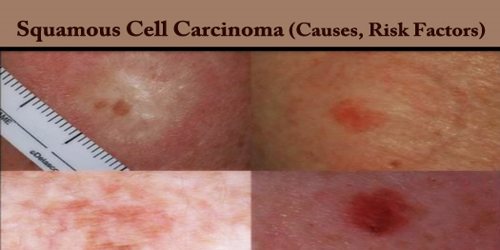Squamous Cell Carcinoma (SCCs), also known as epidermoid carcinomas, of the skin is the second most common form of skin cancer, characterized by abnormal, accelerated growth of squamous cells. When caught early, most SCCs are curable.
Squamous cell carcinoma of the skin is usually not life-threatening, though it can be aggressive. Untreated, squamous cell carcinoma of the skin can grow large or spread to other parts of our body, causing serious complications.
Common types include:
- Squamous cell skin cancer: A type of skin cancer
- Squamous-cell carcinoma of the lung: A type of lung cancer
- Squamous cell thyroid carcinoma: A type of thyroid cancer
- Esophageal squamous cell carcinoma: A type of esophageal cancer
- Squamous-cell carcinoma of the vagina: A type of vaginal cancer
Despite sharing the name “squamous cell carcinoma”, the SCCs of different body sites can show differences in their presented symptoms, natural history, prognosis, and response to treatment.
Most squamous cell carcinomas of the skin result from prolonged exposure to ultraviolet (UV) radiation, either from sunlight or from tanning beds or lamps. Avoiding UV light helps reduce your risk of squamous cell carcinoma of the skin and other forms of skin cancer.
Squamous cells are found in many places in our body, and squamous cell carcinoma can occur anywhere squamous cells are found. Squamous cell carcinoma of the skin refers to cancer that forms in the squamous cells found in the skin.
Causes of SCCs –
One of three main types of cells in the top layer of the skin (the epidermis), squamous cells are flat cells located near the surface of the skin that shed continuously as new ones form. Squamous cell carcinoma of the skin occurs when the flat, thin squamous cells in the middle and outer layers of our skin develop changes (mutations) in their DNA. A cell’s DNA contains the instructions that tell a cell what to do. The mutations tell the squamous cells to grow out of control and to continue living when normal cells would die.
Most of the DNA mutations in skin cells are caused by ultraviolet (UV) radiation found in sunlight and in commercial tanning lamps and tanning beds.
But sun exposure doesn’t explain skin cancers that develop on skin not ordinarily exposed to sunlight. This indicates that other factors may contribute to our risk of skin cancer, such as having a condition that weakens our immune system.
Risk Factors –
While the majority of SCCs can be easily and successfully treated, if allowed to grow, these lesions can become disfiguring, dangerous and even deadly. Untreated SCCs can become invasive, grow into deeper layers of skin and spread to other parts of the body.
Factors that may increase our risk of squamous cell carcinoma (SCC)of the skin include:
- Fair skin. Anyone, regardless of skin color, can get squamous cell carcinoma of the skin. However, having less pigment (melanin) in our skin provides less protection from damaging UV radiation. If any people have blond or red hair and light-colored eyes and they freckle or sunburn easily, they are much more likely to develop skin cancer, including squamous cell carcinoma, than is a person with darker skin.
- Excessive sun exposure. Being exposed to UV light from the sun increases your risk of squamous cell carcinoma of the skin. Spending lots of time in the sun particularly if we don’t cover our skin with clothing or sunblock increases our risk of squamous cell carcinoma of the skin even more.
- Use of tanning beds. People who use indoor tanning beds have an increased risk of squamous cell carcinoma of the skin.
- A history of sunburns. Having had one or more blistering sunburns as a child or teenager increases your risk of developing squamous cell carcinoma of the skin as an adult. Sunburns in adulthood also are a risk factor.
- A personal history of precancerous skin lesions. Having a precancerous skin lesion, such as actinic keratosis or Bowen’s disease, increases our risk of squamous cell carcinoma of the skin.
- A personal history of skin cancer. If we have had squamous cell carcinoma of the skin once, we are much more likely to develop it again.
- Weakened immune system. People with weakened immune systems have an increased risk of skin cancer. This includes people who have leukemia or lymphoma and those who take medications that suppress the immune system, such as those who have undergone organ transplants.
- Rare genetic disorder. People with xeroderma pigmentosum, which causes extreme sensitivity to sunlight, have a greatly increased risk of developing skin cancer.
Complications –
Untreated squamous cell carcinoma (SCC) of the skin can destroy nearby healthy tissue, spread to the lymph nodes or other organs, and may be fatal, although this is uncommon.
The risk of aggressive SCC of the skin may be increased in cases where cancer:
- Is particularly large or deep
- Involves the mucous membranes, such as the lips
- Occurs in a person with a weakened immune system, such as someone who takes anti-rejection medications after an organ transplant or someone who has chronic leukemia
More than 1 million cases of Squamous cell carcinoma (SCC) are diagnosed each year, which translates to about 115 cases diagnosed every hour. SCC incidence has increased up to 200 percent in the past three decades.
Information Sources:
















